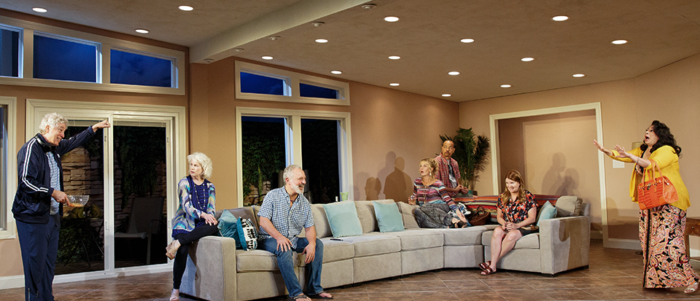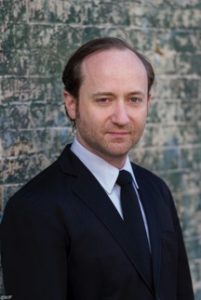
- 05December
-
URTA Alum and Tony Winning Sound Designer, Leon Rothenberg
URTA’s Rachel Friedman recently chatted with California Institute of the Arts alum, Leon Rothenberg about how his training shaped his career, and about his current show “Rancho Viejo”, now playing at Playwrights Horizons.

I would love to start with the beginning of your career. You received your Bachelor of Music from Oberlin and then went to CalArts for your MFA. Can you talk a little about your education and how that helped shape your career?
I started out studying music composition and once I got to Oberlin I added computer science because that seemed like a smart way to get a job at the moment. So I stayed for five years in Oberlin’s dual degree program, where you stay for an extra year and get two degrees. Toward the end of my time at Oberlin I started to collaborate with the theatre department in writing music for plays that they were doing. The first thing I did was called Sons of Light by David Rudkin and I had gotten involved with it because my composition professor was going to write an opera based on the play. It was going to require a big sound design, so the question was “Do you want to do the sound design?” and I thought, “Well, what’s that?” From there I worked with another guy in the electronic music department and we created a soundscape for the play. Then I did one for Women of Troy, Picnic, and a few others. At the same time I was getting a computer science degree and before I graduated, which at that time was not a very good job market, I had been offered a job writing software in Boston, so I took that and I went off to write software for a while.
I started to do sound design for the software we were writing, so I guess I couldn’t stay away from it. I decided I would go back to school for theatre, for grad school, and try to figure out how to be a sound designer—what that meant, and how I could do it. It turns out, if you take composition and you take computer science and you put them together you actually sort of create sound design. In the abstract, the creative process involved in creating code and in writing music are very similar.
Can you talk a little about how you chose CalArts? What takeaways shaped your career and your view on artistry?
Many things. The biggest takeaway of graduate school for me was how to think like a theatre artist. There is a certain mindset when you are doing theatre. A certain way of working in the production process and understanding how to go about making objective decisions about entirely subjective subjects. We all come to an agreement that there will be a circle on the floor, and that that is the correct thing to do. There is nothing to say that the circle on the floor couldn’t be a square, but somehow we all agree in a strangely objective way that it should be a circle. But it is all just us making it up in our heads. So being able to learn the thinking process of analyzing your ideas, thinking critically about your ideas, and being rigorous about justifying your thinking, was the takeaway from grad school. And learning what the industry does, how it works, and what it takes to put on a show was the next step after graduate school. Graduating and giving it a shot was just the practical experience, although much of what I did in graduate school was practical because <ahref=”https://directory.calarts.edu/directory/jon-gottlieb”>Jon Gottlieb, who teaches at CalArts, had us doing a lot of work in the world with him as an assistant or for his rental company, so we were constantly getting practical experience outside school productions and I thought that was incredibly valuable.
You talked about taking those next steps beyond graduate school and I wondered if you could talk about your journey from graduating CalArts to receiving a Tony Award and being a successful sound designer in the industry.
I graduated from CalArts and I stayed in L.A. I was working on any shows I could get people to hire me for, and making relationships with theaters around town. At the same time, as many people do, I took jobs [sound] mixing and doing crew work at various places. I did a bunch of work with Phil Allen at Reprise! in L.A. which is much like Encores! in New York. It was an amazing opportunity to learn how musicals work in a compressed way. You go through the whole process of tech-ing, making a musical, and run for two weekends and then you’re done. You do a bunch of those and you get a sense of how the process works. It was working with Phil where I learned how to mix a musical and got to mix on a Cadac which was pretty exciting, and then how to figure out what goes on backstage and how to run all of that and what goes into making a show. This all prepared me to go to New York eventually and know what to do. From there I got connected with Jonathan Deans who was designing shows in Las Vegas. I worked with him and assisted him on a number of shows over a couple year period then moved to New York in about 2006.

I just saw Rancho Viejo I wondered if you could speak to the process–specifically for that show but also in general–how you choose projects and how you approach a piece.
I try not to say ‘no’. In general the only time I don’t take a project is when the schedule doesn’t work out or I can’t give it my full attention. Otherwise, most anything that comes across my plate is worth doing. Not just because it keeps me working but also there is always something new to do, or try—new equipment to try out or new people to work with. I have never been offered something and not been interested in doing it. I guess the way that I choose the projects is that if I can do the project, then I do them. For Rancho Viejo, Daniel Aukin and I hadn’t worked together before and so the first part of the process is to get to know the director and how they tick, how they communicate, and what they are looking for in a designer and collaborator. From there, it is just kind of reading the play and figuring out what it ought to be and what you think of it, or listening to the ideas of the director or the writer and just kind of running with what they are looking for and expanding on that.
Writers and directors are generative artists—they come up with a structure or a vision and then they rely on designers, who are more reactive artists. We are really good at listening to an idea and taking it ten steps further in our chosen field, so that is what I try to do. I figure out if I am going in the right direction and if I should keep going, or if I’m not, try something else. We came across the structure for the sound for Rancho Viejo because it was suggested by the way the text works with the rhythm of the conversation. There are a lot of notes in the text about environment—the crickets, coyotes, sprinklers, wolves, and all the other things you find in southern California. It was just finding a way to present those elements that supported the dramatic through line without it just being, “Oh, here is background sound.” How can we use crickets to hold tension? We came across this disjointed presentation where the sound and light cut in and cut out really quickly. You take natural sounds which don’t normally behave like that and use them a little differently.
Could you speak to the third act having a very different tone, both through the sound design and other design elements, and how you create that kind of shift in the middle of a piece?
It’s not so hard to do something different if you just decide that you are going to have a beat like that, that is completely left of center. Coming up with what it actually is was sort of a process. When you’ve got a “dream ballet” sequence it has to be very tightly controlled and choreographed rhythmically. We started talking about part three months ago and then Dan wrote drafts and re-wrote and tried to get all the beats and clarify the story first, then clarify the action, and from there add all the supporting elements. It starts from the story that is trying to be told and then we put all the icing on once the story is clear. Sometimes you see a dreamy or realistic movie that is really beautiful but without much of a story behind it, the beauty falls a little bit flat. So it’s always important to make sure the story shines though.
How has your role as an educator–at Bennington, NYU, and CalArts–affected your current work?
In terms of teaching, it has changed my focus from product oriented teaching to process oriented teaching. Designing sound is kind of the easy part. The hard part, in terms of being a designer, is managing the process and learning how to be a good collaborator and all the interpersonal stuff. There is a healthy focus on the actual concrete skills of being a designer but also I like to contextualize it all within the larger picture of the production as a whole. Who is responsible for what, how you get what you want, how you keep what you want, what you want to do in a process, what to do when you are not getting what you want, and why that is okay too. Also things like how to manage your own ego in a process and how to react to external egos in a process are really important and ultimately serve the design you are trying to achieve. So I think I have gotten more focused on that.
Do you have a piece of advice you give your students or early career professionals who are looking at a career in sound design?
One of the most important things I have learned through working in theatre is honesty. You have to be honest with yourself, honest with your collaborators and with the process. That translates into almost everything single thing you do, from the tiny little decision of whether or not to turn something up, to very large decisions like how long will it take to redo some big thing that must happen and we only have three days. All of it requires you to be diplomatic, and you have to read certain situations and act accordingly. Always be honest with everyone, including yourself.
Thank you, Leon!
Posted by URTA Posted on 05 Dec

Post Comments 0